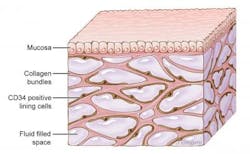Microscopy discovers previously unknown feature of human anatomy
Using a confocal microscopy method, a team of researchers at the New York University (NYU) School of Medicine and collaborators has revealed that layers of the body long thought to be dense, connective tissues below the skin's surface are instead interconnected, fluid-filled compartments. These compartments line the digestive tract, lungs and urinary systems, and surrounding arteries, veins, and the fascia between muscles.
Related: FDA approves laser endomicroscopy system for intraoperative use
This series of spaces, supported by a meshwork of strong (collagen) and flexible (elastin) connective tissue proteins, may act like shock absorbers that keep tissues from tearing as organs, muscles, and vessels squeeze, pump, and pulse as part of daily function.
Importantly, the finding that this layer is a highway of moving fluid may explain why cancer that invades it becomes much more likely to spread. Draining into the lymphatic system, the newfound network is the source of lymph, the fluid vital to the functioning of immune cells that generate inflammation. Furthermore, the cells that reside in the space, and collagen bundles they line, change with age, and may contribute to the wrinkling of skin, the stiffening of limbs, and the progression of fibrotic, sclerotic, and inflammatory diseases.
The researchers say that no one saw these spaces before because of the medical field's dependence on the examination of fixed tissue on microscope slides, believed to offer the most accurate view of biological reality. Scientists prepare tissue this examination by treating it with chemicals, slicing it thinly, and dying it to highlight key features. The "fixing" process makes vivid details of cells and structures, but drains away any fluid. The current research team found that the removal of fluid as slides are made causes the connective protein meshwork surrounding once fluid-filled compartments to pancake, like the floors of a collapsed building.
"This fixation artifact of collapse has made a fluid-filled tissue type throughout the body appear solid in biopsy slides for decades, and our results correct for this to expand the anatomy of most tissues," says co-senior author Neil Theise, MD, professor in the Department of Pathology at NYU Langone Health. "This finding has potential to drive dramatic advances in medicine, including the possibility that the direct sampling of interstitial fluid may become a powerful diagnostic tool."
The study findings are based on newer technology called probe-based confocal laser endomicroscopy, which combines an endoscope with a laser that lights up tissues, and sensors that analyze the reflected fluorescent patterns. It offers a microscopic view of living tissues instead of fixed ones.
The research team collected tissue specimens of bile ducts during 12 cancer surgeries that were removing the pancreas and the bile duct. Minutes prior to clamping off blood flow to the target tissue, patients underwent confocal microscopy for live tissue imaging.
Once the team recognized this new space in images of bile ducts, they quickly recognized it throughout the body, wherever tissues moved or were compressed by force. The cells lining the space are also unusual, perhaps responsible for creating the supporting collagen bundles around them, the authors say. The cells may also be mesenchymal stem cells, Theise says, which are known to be capable of contributing to the formation of scar tissue seen in inflammatory diseases. Lastly, the protein bundles seen in the space are likely to generate electrical current as they bend with the movements of organs and muscles, and may play a role in techniques like acupuncture, he says.
The other first study author was Rebecca Wells of the Perelman School of Medicine at the University of Pennsylvania, who determined that the mesh in the newfound sinus was comprised of collagen and elastin bundles. Also study authors were Jason Reidy of the Electron Microscopy Lab within the Department of Pathology at NYU School of Medicine; Heather Klavan, Markus Miranda, Darren Buonocore, Susan Kornacki, and Michael Wayne of Mount Sinai Beth Israel Medical Center; and Bridget Sackey-Aboagye from the University of Pennsylvania. Carr-Locke is currently clinical director for the Center for Advanced Digestive Care at Weill Cornell Medicine. Benias is an assistant professor at the Donald and Barbara Zucker School of Medicine at Hofstra/Northwell Health.
Full details of the work appear in the journalScientific Reports.

